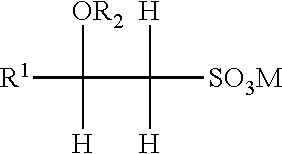Delivery Particles
a technology of delivery particles and packaging, applied in the direction of detergent compounding agents, transportation and packaging, hair cosmetics, etc., can solve the problems of encapsulating a limited breadth and releasing the benefit agent before the tim
- Summary
- Abstract
- Description
- Claims
- Application Information
AI Technical Summary
Benefits of technology
Problems solved by technology
Method used
Image
Examples
example 1
Oil in Water Capsules
[0280]
Water Phase:25gramsacrylic acid butyl acrylate copolymer2grams4,4′-azobis(4-cyano valeric acid)300gramsWater10grams5% NaOHInternal Phase:7.5gramsAmine modified polyether acrylateoligomer17.5gramsDiethylene glycol dimethacrylate1.8gramsMonobutyl maleate247.5gramsButyl diphenyl methane and butyldiphenyl ethane blend1gram2,2′-azobis(2,4-dimethylvaleronitrile)2grams(2,2′-azobismethylbutyronitrile)2.5gramsIndolyl red
[0281]The internal phase is mixed with stiffing for one hour under a nitrogen blanket and brought to a temperature of 65° C. and maintained at this temperature. The water phase components are also mixed with stiffing. The oil phase components are blended at high speed. The water phase is added to the internal phase and milled for an additional two hours at 65° C. to achieve a median particle size of about 3.6 μm. The temperature is maintained along with continuous stiffing for four hours; and then heating is increased to 90° C. for eight hours.
[0282...
example 2
[0284]
Water Phase:300gramsWater25gramsacrylic acid butyl acrylate copolymer2grams4,4′-azobis(4-cyano valeric acid)10grams5% NaOHInternal Phase:247.5gramsButyl diphenylmethane andbutyl diphenylethane blend2.5gramsIndolyl red dye7.5gramsAmine modified polyether acrylateoligomer (CN 551 ™, Sartomer,Exton, Pennsylvania)17.5gramsEthylene glycol dimethacrylate1.5grams2,2′-azobis(2,4-dimethylvaleronitrile)0.5grams(2,2′-azobismethylbutyronitrile)1.0grams1,1′-azobis(cyanocyclohexane1.8gramsMonobutylmaleate
[0285]The internal phase is mixed with stiffing for one hour at 70° C. under a nitrogen blanket. The water phase components are also blended with stirring. The oil phase components are blended at high speed. The water phase is added to the internal phase and milled for an additional two hours at 70° C. to achieve a median particle size of 3.7 μm. The temperature is maintained along with continuous stirring for four hours and then heating is increased to 90° C. for eight hours. The resultant...
example 3
[0286]
Permeability of resultant capsulesWall Material(methanol extraction)Diethylene glycol dimethacrylate3.77Diethylene glycol diacrylate15.89Aromatic urethane acrylate0.00Urethane acrylate17.80Tetraethylene glycol diacrylate41.361,4-butane diol diacrylate1.61Ethylene glycol dimethacrylate0
[0287]Permeability can be controlled through wall material selection, through control of the degree of cross-linking, by controlling temperature of cross-linking, by controlling length of time of cross-linking, or with UV initiated systems by controlling intensity of UV light and duration.
[0288]Permeability is determined by extracting for 5 seconds using methanol and measuring relative coloration of extracted dye.
PUM
 Login to View More
Login to View More Abstract
Description
Claims
Application Information
 Login to View More
Login to View More - R&D
- Intellectual Property
- Life Sciences
- Materials
- Tech Scout
- Unparalleled Data Quality
- Higher Quality Content
- 60% Fewer Hallucinations
Browse by: Latest US Patents, China's latest patents, Technical Efficacy Thesaurus, Application Domain, Technology Topic, Popular Technical Reports.
© 2025 PatSnap. All rights reserved.Legal|Privacy policy|Modern Slavery Act Transparency Statement|Sitemap|About US| Contact US: help@patsnap.com



